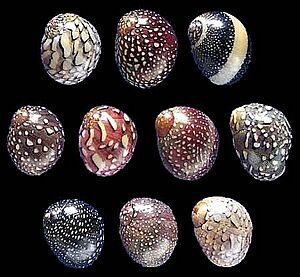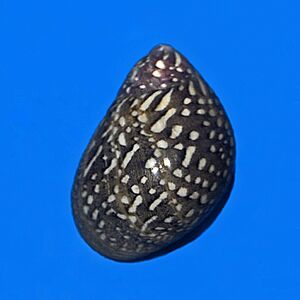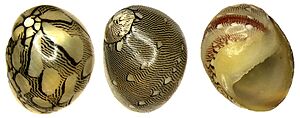Virgin nerite facts for kids
Quick facts for kids Virgin nerite |
|
|---|---|
 |
|
| Shells of Vitta virginea | |
| Conservation status | |
| Scientific classification | |
| Genus: |
Vitta (gastropod)
|
| Species: |
virginea
|
| Synonyms | |
|
|
The virgin nerite, also known by its scientific name Vitta virginea, is a type of sea snail. It is a marine mollusk that belongs to the family Neritidae. These snails are known for their beautiful, colorful shells.
Contents
Where Virgin Nerites Live
Global Distribution of Vitta virginea
The virgin nerite snail is found in many places around the world. It lives across a wide area, including the Bahamas, Bermuda, and Cuba. You can also find them in the West Indies, which includes the Greater and Lesser Antilles, Dominica, and Puerto Rico.
These snails are also common in Central America. This includes countries like Panama, Guatemala, and Costa Rica. Further south, they are found in Brazil, Venezuela, Suriname, and Colombia. In North America, they live in Mexico, Texas, and Florida.
Habitat and Environment
Where Vitta virginea Makes Its Home
Vitta virginea snails are very adaptable. They can live in many different kinds of water. This means they can survive in fresh water, salty ocean water, and even brackish water. Brackish water is a mix of fresh and salt water, often found where rivers meet the sea.
These amazing sea snails live in various places. You can find them in rivers and streams, as well as in estuaries. Estuaries are areas where fresh river water mixes with the ocean's salt water. They also live directly in the sea. They prefer to live on sand, silt, and stones. You might also spot them in brackish ponds and among mangrove trees.
Physical Description
What Virgin Nerite Shells Look Like
The shells of Vitta virginea are quite small. They usually grow to be about 6 to 25 millimeters long. That's less than an inch! These snails are famous for their incredibly varied colors and patterns. No two shells look exactly alike.
Their shells are shaped like a half-sphere. They have about 3 or 4 turns, called whorls. The opening of the shell, called the aperture, is oval-shaped. It has thin edges. The operculum, which is like a little door that closes the shell, is usually black. The shell's surface is smooth and shiny. It can be black, grey, white, yellow, olive green, red, or purple. Many shells also have cool stripes, wavy lines, spots, or other unique designs.
Biology and Life Cycle
How Virgin Nerites Live and Eat
Virgin nerites are herbivorous, which means they eat plants. Their main food source is algae. They scrape algae off rocks and other surfaces.
These snails are also known for being diadromous. This is a special word meaning they move between fresh and salt water during their life cycle. They are involved in huge migrations, often moving upstream in rivers. This movement is part of their life cycle, likely for reproduction or finding food.




